Travels and Stories
by Michael Frye | Nov 12, 2017 | Light and Weather, Travels and Stories
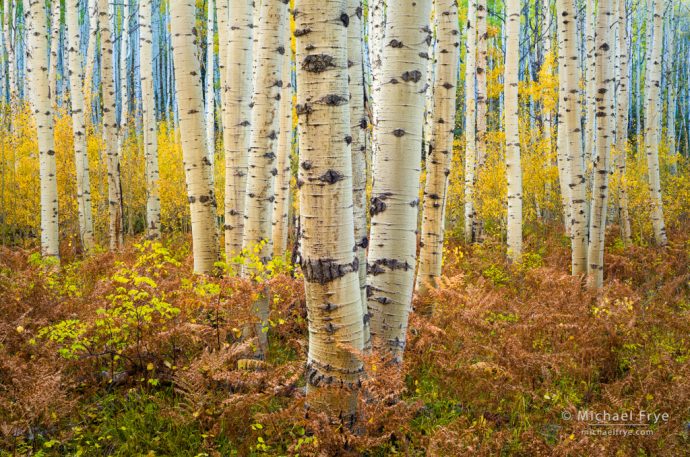
Aspens and ferns, autumn, Grand Mesa-Uncompahgre-Gunnison NF, CO, USA
Claudia and I had wonderful conditions on our autumn trip to Colorado. As I said before, it wasn’t the best year for fall color there, but the weather more than made up for that, with rain, snow, fog, and lots of interesting clouds.
We chased the weather and color all over Colorado – or so it seemed. We reached the San Juan Mountains in the southwest corner of the state on September 27th, but found little color at that time. So we headed east and ended up near Twin Lakes, where I photographed aspens with snow and fog. Then we drove over Independence Pass and spent a couple of days around Aspen and Carbondale, braving the crowds to capture a misty view of the Maroon Bells.
(more…)
by Michael Frye | Oct 22, 2017 | Travels and Stories, Yosemite Photo Conditions
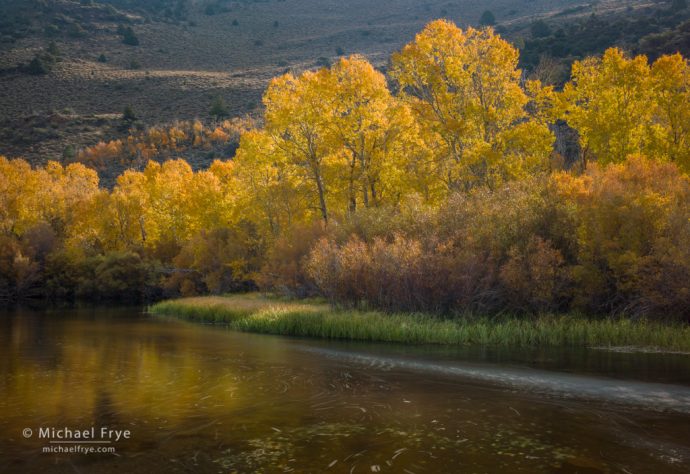
Autumn scene along Rush Creek, Inyo NF, CA, USA
We just finished our workshop on the eastern side of the Sierra. When I arrived a few days before the workshop the aspen color was rather mixed, with bare trees, green trees, and every stage in between. But the weather was cold, and things turned quickly. By the time our workshop started most of the green leaves had turned yellow and orange, and we found lots of beautiful color – particularly along the June Lake Loop.
(more…)
by Michael Frye | Oct 9, 2017 | Light and Weather, Travels and Stories
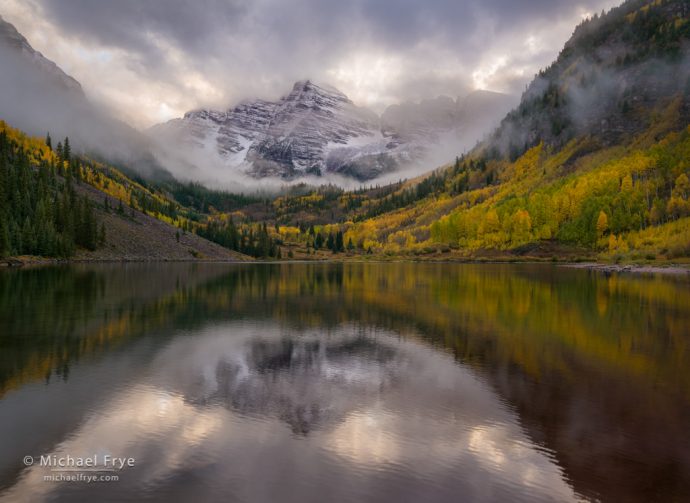
Maroon Bells in autumn, White River NF, CO, USA
Some photographers love photographing icons, and try to visit as many as possible. Others avoid them at all costs.
But I think most of us have mixed feelings about them. These iconic spots have a certain undeniable appeal. There are good reasons, after all, why these places have become iconic: they’re great locations. With the right conditions, it’s possible to capture some beautiful images at these spots. They work.
(more…)
by Michael Frye | Oct 1, 2017 | Travels and Stories
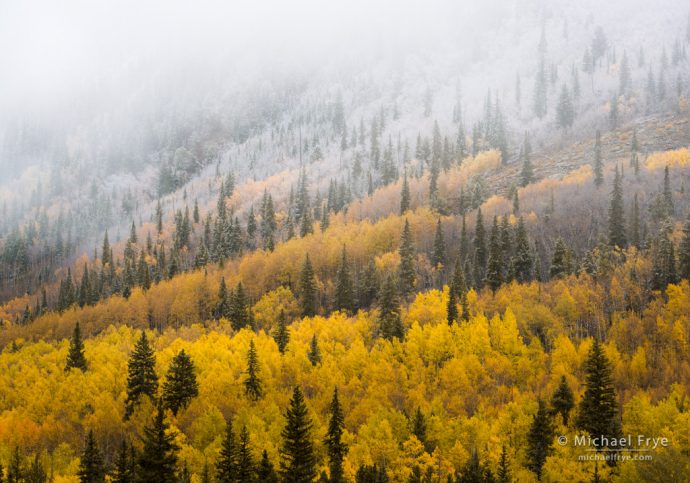
Autumn hillside with aspen and spruce trees, Pike-San Isabel NF, CO, USA
Claudia and I are in Colorado, chasing the fall color once again. By Colorado standards this is a below-average year for autumn color. Apparently a mid-May snowstorm damaged some of the just-sprouting aspen leaves, and those leaves are turning brown or dull yellow before falling off.
But many of the aspens seem to be undamaged. And it’s Colorado after all, where there are so many aspens that even in a “poor” year you can find plenty of colorful trees. And we’ve had some great weather, with rain, snow, fog, and lots of interesting clouds. The combination of weather and color has been really fun to photograph, and the constantly-changing conditions have kept me going from sunrise to sunset every day. Here are a few images showing some of the best moments so far, and I’m sure I’ll post more soon.
(more…)
by Michael Frye | Aug 27, 2017 | Travels and Stories
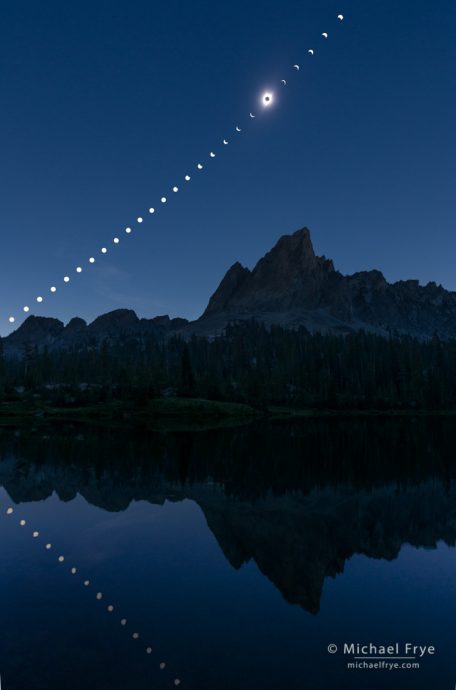
Solar eclipse sequence, Sawtooth Mountains, ID, USA, August 21, 2017
Watching the eclipse was an amazing experience. But for Claudia and me, getting to that moment was quite a journey.
I first heard about this eclipse several years ago, and started making plans to photograph it. But I didn’t make any reservations because I wanted to stay flexible, and be able to go where the weather looked best.
Months ago I virtually scouted locations along the eclipse path using online photographs, Google Earth, and The Photographer’s Ephemeris 3D. I knew that thousands of people would capture beautiful, closeup photographs of the eclipsed sun. But I’m a landscape photographer, and wanted to incorporate the eclipsed sun into a wider scene. As I wrote in my last post, that was difficult to do with this eclipse, because the sun would be so high in the sky. You needed something tall in the foreground, or else you had to get the camera down low and look up at a foreground object.
(more…)
by Michael Frye | Apr 13, 2017 | Travels and Stories
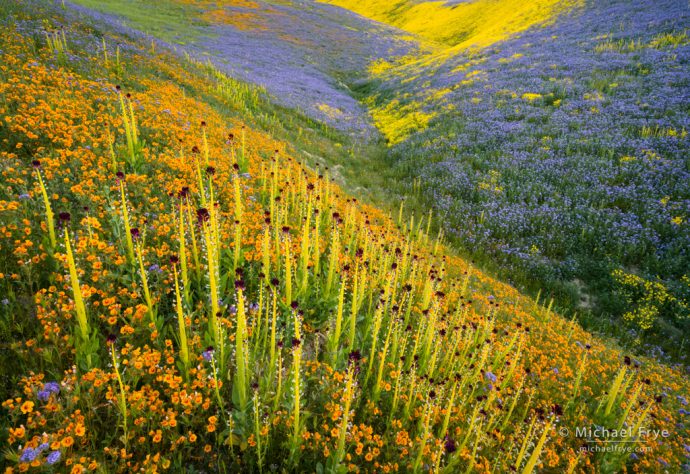
Wildflowers in the Temblor Range, with desert candles, blazing stars, tansy phacelia, and hillside daisies, Carrizo Plain National Monument. I used a wide-angle lens (20mm) to be able to look down into the stand of flowers in the foreground and show more of the orange color (the blazing stars), while also including part of the colorful hillside in the background. 1/6 second at f/16, 800 ISO.
Many years ago – perhaps around 2005 – I saw a striking photograph of flowers in the Temblor Range, bordering the Carrizo Plain. I wanted to go there, and in April of 2006 I did, finding a route up the steep ridges of these mountains to a colorful hillside. The flowers weren’t as abundant that year as they were in the photo I saw, but it was still beautiful, and I was able to make a couple of images I liked.
In 2010, after seeing reports of a great flower bloom in the Carrizo Plain, I returned to the area and hiked up into the Temblors again. It was spectacular – the most amazing flower display I had ever seen. I could only spend one afternoon and one morning there, but it was a wonderful 24 hours. The hills were enveloped in thick fog on my one morning there, and spots of sunlight breaking through the fog created some beautiful light. I could see, however, that the flowers wouldn’t last long, and I wasn’t able to go back that spring, but ever since then I’ve wanted to return.
(more…)














